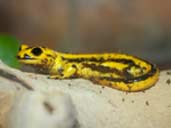 |
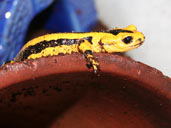 |
||
Bernadezi Fire Salamander |
Bernadezi Fire Salamander S.s. bernadezi |
Fire salamander Care Sheet
Common names: Fire Salamander
It is believed that Fire Salamanders received their name by hiding in logs chopped for burning and then running out once the logs were placed on the fire. A myth grew up over this habit and our ancestors believed that they could not only withstand fire, but also that they lived in it.
Scientific Name: Salamandra salamandra
There are two main sub-species that are commonly found in the pet trade. These are Salamandra salamandra salamandra and Salamandra salamandra terrestis. S.s terrestis is sometimes called the Barred Fire Salamander. This care sheet will focus on these two species, but here is a list of some other Salamanders in the Salamandra salamandra family:
Spotted Fire Salamander - Salamandra salamandra almanzoris
Yellow Striped Fire Salamander - Salamandra salamandra fastuosa
Bernadezi Fire Salamander - Salamandra salamandra bernadezi
Near Eastern Fire Salamander - Samandra salamandra inframmaculata
Portuguese Fire Salamander - Salamndra salamandra gallaica
Corsican Fire Salamander - Salamandra salamandra corsica
Los Barrios Fire Salamander - Salamandra salamandra longirostris
Description
Description: Depending on the type of Fire Salamander you have, their dorsum colours tend to be a glossy black with bright yellow blotches on their bodies. This yellow colouration varies between the species and is usually the way that the sub-species are differentiated from each other.
They are quite stocky salamanders with long tails and visible parotoid glands in the area behind their protruding eyes.
Size: Fire Salamanders generally grow to between 18 to 25cms (7-10inches) in length, but it is not unknown for them to reach 30cms (12inch) in some cases.
Life span: Captive Fire Salamanders can live up to 30 years with appropriate care.
Origin: Fire salamanders are found throughout Central and Southern Europe, into West Asia and Northern Africa.
Habitat: The Fire Salamander has two specific phases in its life cycle, which both determine the habitat that they are found in. The larvae are entirely aquatic, living in ponds and shallow lakes. Adults are terrestrial and only return to the water for breeding purposes. They can be found burrowing in the forest floor and hiding in the undergrowth and under logs and stones. They are hardly ever seen out in the open and prefer their habitat to be damp and cool.
Things to consider before buying a Amphibian as a pet
• Who will look after your new pet if you are away?
• Can you get food easily from your local pet shop?
• Can you deal with feeding live insects as food?
• Can you handle the live food to feed your pet?
• Is the rest of the family happy to live with an amphibian?
Captive Care
Temperament
Fire salamanders are highly inquisitive and lively salamanders, but are nocturnal, so are more often seen exploring their tank in the evening and at night. They make an ideal first amphibian as they are relatively easy to care for, as long as low temperatures can be maintained. They can become quite tame with regular interactions with their keeper.Regardless of ease of care, it should be noted that Fire Salamanders have paratoid glands that secrete a toxin that can cause skin irritations, so this should be taken into consideration if you are thinking about getting a Fire Salamander as a family or children’s pet.
Feeding
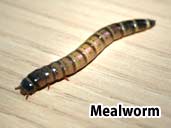 |
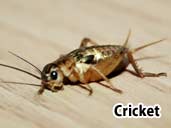 |
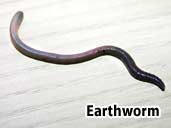 |
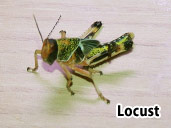 |
Salamanders should be fed 2-3 times weekly with a varied diet of appropriately sized gut loaded insects, including meal worms, crickets, small grass hoppers, flour beetles, wax-worms, moths, caterpillars, earthworms, snails, spiders, roaches and woodlice. Feed 3 or 4 insects per salamander per feeding. The live food should be dusted with calcium supplements weekly, especially as they grow from Juvenile to adult.
As adults your Salamander should be able to feed on the occasional pinkie mouse, but you should regard this as a treat item as regular feedings on mice can cause your Salamander to become obese.
Fire salamanders will actively hunt their food, instead of waiting for it to come to them like some other frogs and salamanders. This makes them enjoyable to watch at feeding time. In the wild Fire Salamanders will occasionally take carrion (dead prey items), as they also use their sense of smell to hunt out food, rather than just being attracted to movement.
Handling
Fire Salamanders are one of the few amphibians that can be handled, but it should not be done too regularly or for prolonged amounts of time. It is advisable to wash your hands both before and after handling or preferably wear latex gloves. This is because the white secretions that ooze out of your Fire Salamander’s parotoid glands are highly toxic and can cause skin irritations. It is also advisable for the welfare of your Fire Salamander, as amphibians are delicate skinned and oils and salts on our skin can cause them harm.
When cleaning you can safely remove your salamanders to another tank using an aquarium net usually used for pet fish.
Sloughing
Fire salamanders shed their skin at regular intervals as they grow. The old skin is pushed off with the hind legs and the skin peels off from the back end. The skin should come off in one piece and is normally eaten by the salamander. The skin is pushed forwards using it’s legs towards the mouth.
Housing
Adult Fire Salamanders are quite lively and require a larger terrarium than most ground dwelling amphibians. A 15-20 Gallon tank should be adequate for 2 adult salamanders. They are quite social and can be housed with other Fire salamanders.
Fire salamanders do well in a savannah/woodland set-up.
Your terrarium should contain:
Substrate
A coco husk substrate, sandy top soil or compost (without fertilisers), orchid bark chips, sphagnum moss, peat, live moss, leaf litter, sand and a selection of live plants can all be used in your set-up. Avoid using vermiculite and gravel as these are no good for burrowing.A simpler, but less attractive substrate is paper towels. These are cheap, fit for purpose and easy to clean if they become soiled, but be aware that your Fire salamander is a natural burrower, so is more likely to appreciate a substrate that allows it to burrow.
Somewhere for your Fire Salamander to hide.
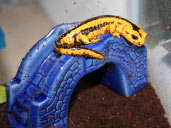 All amphibians require somewhere to hide and may become stressed if this is not provided. This could be a plant pot on its side, which is low cost but easily cleaned if it becomes soiled.
All amphibians require somewhere to hide and may become stressed if this is not provided. This could be a plant pot on its side, which is low cost but easily cleaned if it becomes soiled.
Logs and cork bark make good natural looking additions to your terrarium and make great hiding places. Plants and stones can also be used.
Stones or branches from the wild need to be debugged by soaking first in chlorine/water solution, then rinsed thoroughly, soaked in clean water, then left to dry in the sun. Some live plants may be harmful to your salamander, if in doubt please see the list of safe plants which can be used in the forum.
If you are keeping multiple Fire Salamanders in a terrarium then ensure there is a hide for each of the salamanders housed.
A change of scenery
Fire salamanders are very inquisitive animals and like to explore new surroundings. Once in a while change the layout of the terrarium; this will keep your salamander from becoming bored. You will notice once you put your salamander(s) back in the tank it will start to re-explore its new surroundings.
Water
All amphibians need fresh water daily. A large water bowl should be given (no deeper than the salamanders height when at rest) with de-chlorinated or bottled spring water. The water should be changed daily to avoid the build up of bacteria.
Salamanders like most amphibians will soak up water through their skin and since their water bowl is used as the main place to defecate it is important that it is cleaned regularly.
If you would like a more elaborate set up then a 50/50 split to the tank is also an option. Dedicate half the terrarium to terrestrial burrowing space and the other half to a water area. A filter may be added to help keep the water clean and it is advisable to have a ramp between the two areas to aid your Fire Salamanders when leaving the water.
Humidity
Fire Salamanders do not require high humidity, but a little more than normal room humidity should be maintained. Misting the tank regularly with de-chlorinated or bottled spring water will ensure that the substrate does not dry out. It is important to ensure that the substrate remains damp, but not water logged.
Temperature
The ideal temperature for your salamanders is around 15-20°C (60-68°F) with a slight temperature drop at night of 5°C degrees.
It is useful to have a small thermometer on either end of the terrarium to check the temperature, as it is very important that low temperatures are maintained. Fire Salamanders are not heat tolerant and temperatures above 23-24°C (75°F) can cause your Fire Salamander to suffer from heat stress.
Symptoms of heat stress included long periods spent in the water bowl, constantly trying to escape the terrarium, pacing, anxiousness and loss of appetite. If your Fire Salamanders have any of these symptoms, check the temperatures within the terrarium immediately to ensure that they have not risen dangerously high.
To keep your Fire Salamanders at a cool temperature it is advised to place the terrarium in a room without central heating or where is can be guaranteed to be cooler like an unused bedroom or a garage. Some keepers build outdoor enclosures so they can keep their Fire Salamanders outside year round, to ensure that the temperatures do not get too high as they might within a house.
Lighting
Fire salamanders do not need the edition of UV lighting if they have enough vitamins and variation in their diet. Although you may find the live plants in your terrarium will die without any light. A fluorescent UVB tube is ideal as it won’t give out any heat and will help the plants thrive.
You should place the light at one side of the terrarium creating a light gradient so your salamanders can find a darker place out of the light if preferred. Ideally you should cycle the lighting to mimic the salamander’s natural habitat by having a 12/12 system - 12 hours of light and 12 of dark.
Normal bulbs should be avoided within the terrarium, due to the amount of heat they would generate.
Cleaning
Your Fire Salamander’s terrarium should be inspected and spot cleaned daily when changing the water. Every two to three weeks clean out the tank completely and sterilise using a reptile/amphibian friendly disinfectant. Sterilise any décor and carefully remove any live plants to replace when the tank has been cleaned. Your salamanders should be moved to a temporary tank whilst being cleaned.
Breeding your Fire Salamanders
Sexing
Sexing your Fire Salamanders is difficult unless it is the breeding season and they are adults. Generally female Fire Salamanders tend to be larger than males, but the easiest way to determine sex is by looking for the swollen gland near the vent that males develop during the breeding season. This swollen gland is caused by the male’s spermaphone (sperm packet), which he develops in preparation of an encounter with a female.
The Breeding Process
The breeding season for Fire Salamanders is generally early autumn. Breeding at this time means that larvae should be expected in the early spring.
Fire Salamanders reach sexual maturity at about 3-4 years of age and should be a good health and weight before they are allowed to breed.
If you are planning to breed your Fire Salamanders, it is recommended that you allow them a period of hibernation beforehand. This is achieved by not feeding your Salamanders for approximately 2 weeks before slowly lowering the temperatures to around 5-7°C (41-45°F). Some breeders use a fridge to ensure that the temperatures remain low enough during this time. When your Salamanders are ready to come out of hibernation, bring the temperatures up slowly by just a few degrees a day.
Mating takes place on land, with the male depositing his spermaphone for the female to pick up. She then carries it around for months, before the larvae are deposited in the water. A large water bowl should be placed in the terrarium to allow the female to give birth, but then removed to separate the mother from the larvae.
Larvae care
Larvae are fully aquatic and can be housed in a suitable aquarium and fed on a variety of small prey items, including chopped earthworms, daphnia, fruit flies, white worms, bloodworms, black worms and insect larvae.
Metamorphosis occurs in approximately 1 month, at which point they will become terrestrial, so a land area is needed to ensure that they can leave the water easily and continue their lives on land.
Additional Questions about Fire Salamanders
If you have any other questions why not join The Amphibian Forum and ask one of the many experienced keepers. The reason this website was set up was so people in the amphibian keeping hobby could share their experiences with others.

